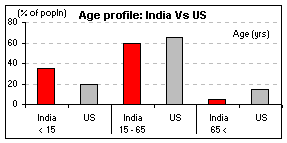Stockmarkets: Cues from demographics...
 Change in demographics
The democratic patterns across the globe are witnessing a major shift with the change in the proportion of dependant population. Developed countries like the US are set to have nearly 70% of the population in the dependant category by 2010 (Source: IMF), thus burdening the already sagging social security system. Even China, the fastest growing economy in the world, is set to face a setback due to the fast ageing population. On the other hand, India, with nearly 60% of the population in early 30's by 2010 is likely to be one of the youngest nations by then. As per a United Nations report, in 2050, six countries (including India) will have more than 10 m people aged 80 years or above. Together they will account for 57% of all those 80 years or above in the world. However, in terms of percentage of population in the dependant category, India stands to be fairly better off.
Change in demographics
The democratic patterns across the globe are witnessing a major shift with the change in the proportion of dependant population. Developed countries like the US are set to have nearly 70% of the population in the dependant category by 2010 (Source: IMF), thus burdening the already sagging social security system. Even China, the fastest growing economy in the world, is set to face a setback due to the fast ageing population. On the other hand, India, with nearly 60% of the population in early 30's by 2010 is likely to be one of the youngest nations by then. As per a United Nations report, in 2050, six countries (including India) will have more than 10 m people aged 80 years or above. Together they will account for 57% of all those 80 years or above in the world. However, in terms of percentage of population in the dependant category, India stands to be fairly better off.
Changes in investment patterns Demographic changes in countries have major implications for investment risks and returns. This is because the combination of declining birth rates and ever increasing numbers of pensioners can have inopportune consequences for investment and wealth creation. In fact, the risk associated with any economy is calculated keeping substantially ageing populations in mind.
A younger population implicates higher earning ability, more consumption demand and investment across asset classes (risky as well as non-risky). On the other hand, an ageing population is largely dependant on the pension or savings income and restricts investments to low risk assets. Thus, while in the case of the former, equity returns get a boost due to better corporate earnings and liquidity, in the case of the latter, a stagnating economy and limited community of investors imposes restrictions on such asset class.
Nevertheless, it needs to be kept in mind that despite the challenges posed by an ageing population, it is feasible that investment and consumer behavior may change for the better as a result of large influx of immigrants. Also, business cycle trends caused by different factors such as entrepreneurship, investment or technological developments, may prove to be more significant than population changes. If such trends do prevail, they may negate the impact of demographic changes on economic growth.
Implications for Indian markets Better economic growth perpetuates into a 'demonstration effect' from the developed economies to the developing economies. In fact, the rise in demand for consumer goods, shift in demand from unorganised to organised markets, demand for credit and deeper penetration almost forms a benign cyclical trend, which in turn, triggers a consumption-led growth. While this is certainly advantageous as it insulates the economy from variations in export demand, it is so as long as the country does not become excessively import and credit dependant. The Indian economy, thus, needs to capitalise on the opportunities offered by the young demographic profile, without hurting its capital and current account balances. Summarising this concept, someone aptly quoted, "Demography is always in flux, and so are the investment opportunities associated with it."
Source: EM
- Top Picks - Tower Capital
- Sugar - ICRA
- Asia Equity Strategy - UBS
- Banking Sector - Enam
- Steel Sector - ICICI
- The first rule is not to lose. The second rule is not to forget the first rule. - Warren Buffett